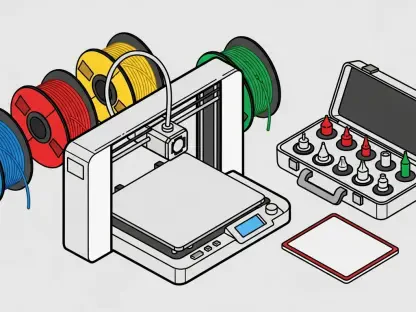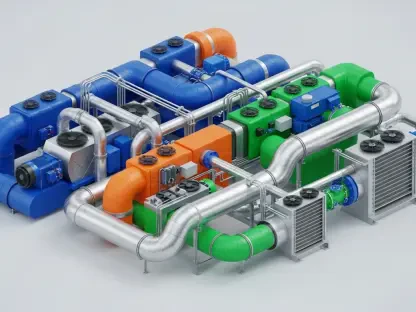The cannabis industry finds itself at a defining crossroads, where the path to prosperity or peril is determined by a single, transformative factor: automation. As market projections from Grand View Research indicate a meteoric rise in the global cannabis technology sector from $4.84 billion in 2023 to an astonishing $23.46 billion by 2030—a growth of 385%—the stakes have never been higher for manufacturers to abandon outdated, labor-intensive methods. Automation emerges as the lifeline for companies wrestling with shrinking profit margins, persistent labor shortages, and ever-increasing consumer demands for quality and speed. This shift is not a mere trend but a fundamental necessity for survival in a market growing more competitive by the day. Beyond just keeping pace, automation offers a strategic advantage, enabling businesses to streamline operations, cut costs, and meet demand with unparalleled efficiency. This article delves into the critical role of automated systems, exploring how they reshape the industry and why adopting them is no longer optional but imperative for long-term success.
The Competitive Edge of Automation
Operational Efficiency and Cost Savings
Automation stands as a game-changer in addressing the cannabis industry’s most urgent challenges, particularly in slashing operational inefficiencies. By integrating technologies like pre-roll infusers, joint rollers, and advanced packaging systems, manufacturers can drastically reduce reliance on manual labor, which often drives up costs and slows production cycles. This transition to automated processes not only trims expenses but also guarantees consistent product quality—a vital element in earning and retaining consumer trust in a crowded marketplace. The ability to maintain uniformity across batches ensures that brands can deliver reliable experiences, fostering loyalty amid fierce competition. Furthermore, automation empowers companies to scale production rapidly to match rising demand without incurring proportional increases in overhead, creating a leaner, more agile operation capable of capitalizing on market opportunities with precision and speed.
Beyond cost reduction, the efficiency brought by automation reshapes the very structure of cannabis manufacturing, aligning it with broader industrial advancements. Consider the U.S. manufacturing sector as a benchmark, where automation has boosted goods production by 44% while reducing labor needs by 70% over recent decades. In the cannabis space, this translates to fewer human touchpoints, minimizing errors and variability in output. Such precision is critical when price compression threatens profitability, as every manual step becomes a potential liability draining resources. Automated systems offer a buffer against these pressures, allowing businesses to redirect savings into innovation or market expansion. This strategic reallocation can mean the difference between stagnation and growth, positioning forward-thinking companies to thrive in an environment where efficiency is not just an advantage but a prerequisite for relevance.
Real-World Success Stories
The tangible impact of automation in cannabis manufacturing comes to life through compelling examples of industry players who have embraced these technologies. One manufacturer implemented a robotic pre-roll infusion system, seamlessly transforming standard pre-rolls into infused joints without sacrificing production volume. This innovative shift resulted in a notable 10% increase in gross margin, driven by the higher perceived value of the infused product among consumers. Such a move highlights how automation can enhance not just efficiency but also profitability by tapping into evolving market preferences. The ability to adapt quickly to trends like the rising demand for infused products demonstrates the power of technology to create competitive differentiation without overhauling existing workflows, offering a blueprint for others in the sector to follow.
Another striking case involves a concentrate producer with no prior experience in pre-rolls who ventured into the market by adopting an automated infusion machine for white-label products. Within just 18 months, this company scaled its operations from a single machine to three, catapulting it into the ranks of the top ten infused pre-roll producers in its region. This rapid ascent underscores how automation can open new revenue streams and enable businesses to penetrate untapped segments of the market with minimal risk. By aligning technological investments with consumer demand, the producer not only achieved scalability but also established a foothold in a niche area, proving that automation serves as both a tactical tool for growth and a strategic lever for market positioning. These stories collectively illustrate the transformative potential of automation to redefine success in the cannabis industry.
Navigating the Automation Arms Race
Industry Trends and Market Dynamics
The cannabis sector is currently embroiled in what can be described as an intense “automation arms race,” with manufacturers scrambling to adopt state-of-the-art technologies to secure a dominant position in the market. Unlike other industries that have long since integrated automation into their core operations, much of cannabis manufacturing remains tethered to inefficient, analog processes that hinder scalability and consistency. However, recent market growth projections signal a pivotal shift, with an increasing number of companies recognizing the need to modernize. Failure to keep up with this wave of innovation risks obsolescence, as competitors who automate gain significant advantages in cost management, product quality, and delivery speed. The prevailing sentiment among industry observers is that embracing automation is the only viable path to maintaining relevance in a landscape defined by relentless competition.
This race to automate is further fueled by macro-level pressures that amplify the urgency for change within the cannabis industry. Labor shortages, rising material costs, and maturing consumer expectations are converging to create a perfect storm where manual processes are no longer sustainable. Companies that invest in automated systems are better equipped to navigate these challenges, achieving economies of scale that manual operations simply cannot match. Moreover, the strategic alignment of automation with specific market demands—such as the growing popularity of infused products—enables businesses to maximize returns on their investments. The evidence suggests that those who act decisively can see returns within months, often reflected in double-digit margin improvements. This dynamic underscores the critical need for manufacturers to view automation not as a luxury but as an essential component of their long-term strategy for market dominance.
Overcoming Challenges and Strategic Implementation
Implementing automation in cannabis manufacturing is not without its complexities, chief among them being the fluid nature of production bottlenecks that differ from those in traditional industries. In cannabis, as one segment of the production line becomes more efficient through automation, bottlenecks often shift to another area, creating a moving target for optimization. This unpredictability can discourage investment, as some manufacturers perceive the process as overly complicated or fear that solutions may not yield immediate results. Yet, this challenge is not insurmountable; a pragmatic approach involves starting with a comprehensive audit of the production line to identify specific pain points. By addressing these issues incrementally with targeted automated solutions, companies can avoid the overwhelm of a full-scale overhaul while steadily building a more streamlined operation tailored to their unique needs.
A strategic, step-by-step adoption of automation also offers a pathway to mitigate risks and ensure alignment with market realities, fostering sustainable progress. Manufacturers can prioritize technologies that directly address consumer trends, such as automated systems for infused pre-rolls, which command higher margins and meet growing demand. This focused investment helps maximize return on investment by ensuring that automation efforts are not just reactive but proactive in capturing market share. Additionally, a phased implementation allows for continuous evaluation and adjustment, enabling businesses to refine processes without disrupting existing operations. The key lies in viewing automation as a customizable strategy rather than a one-size-fits-all fix, adapting it to specific operational goals. By taking measured steps, companies can overcome resistance to change, build internal expertise, and position themselves as leaders in an industry where smarter systems, not more labor, will define the future.









